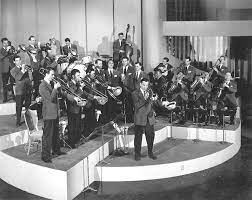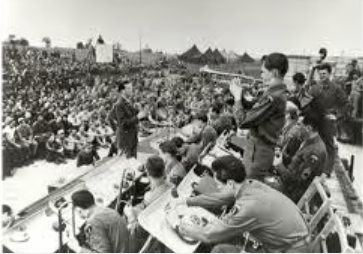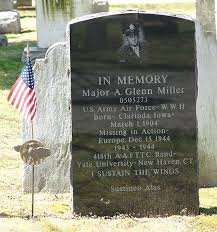
Glenn Miller’s Last Flight
Today, as I finally begin to feel the approach of Christmas, I’m in the mood for…Glenn Miller. I always think of him around this time of year. Have you seen the movie, The Glenn Miller Story, starring James Stewart and June Allyson? It’s fabulous and I never tire of watching it, but I warn you, you will need tissues for the end. And it’s so fitting that James Stewart should have played Glen Miller, as he too served during WW2.
So, Alton Glenn Miller. Born March 1st, 1904 in Clarinda, Iowa. When he was around seven or eight years old, his father brought home a mandolin for him to play, but Glen soon traded it for a horn, practicing whenever he could. In 1923, he attended the University of Colorado, but after failing several courses one year, he dropped out and decided he’d give music a shot. It was while he attended the university, that he met his future wife, Helen Burger.

Glenn Miller with his trombone. Image courtesy of wikimedia commons.
Over the next few years he toured with several orchestras, met Benny Goodman, and had the chance to write musical arrangements. In 1928, he married his college sweetheart and continued earning a living as a musician, playing the trombone and arranging music.
Miller worked the circuit, played and recorded with some of the big names at that time, including the then up-and-coming singer, Bing Crosby. In 1934, Glenn was offered the chance to be the musical director of the Dorsey Band, and later, the Ray Noble Orchestra.
The young, talented musician, arranger, composer and bandleader, however, sensed that something was missing, and he was determined to find the right “sound”. As Glen once said, “A band ought to have a sound all of its own. It ought to have a personality.” – Glenn Miller

Glenn Miller & his orchestra in concert.
He recorded under his own name for the first time in 1935, but while he made a few hundred sales, he stuck with the Noble Orchestra. Two years later, he left to form his own band, but failed to find the success he strove so diligently to achieve, and they soon disbanded. Glenn was broke, and a little lost. It was during this period he made a breakthrough discovery – the reed section sound. The unique sound was the key that would enable his band to outshine the rest, to stand on their own.
The Glenn Miller Orchestra formed in March 1938 and in a very short time began to attract huge audiences wherever they played. It is said they attracted the largest dancing crowd at the New York State Fair in Syracuse. They played at Carnegie Hall with three top bands but it was the Glenn Miller Orchestra that gained the most applause that night. Finally, they were on their way and the rest is history, as they say.
We all know and love the hits that followed, In the Mood, Moonlight Serenade, Little Brown Jug, Pennsylvania 6-5000 and Tuxedo Junction. In 1941, Hollywood beckoned and the band made a movie – Sun Valley Serenade, featuring more hits like Chattanooga Choo Choo. A second movie followed. Meanwhile, in Europe, war gathered pace, and on December 7th 1941, Japan bombed Pearl Harbour. America waged war and men raced to volunteer to serve as the draft was swiftly put into action.

Major Glenn Miller in the USAF uniform, 1942.
Glen reported for service with the United States Army Air Force on the 7th October 1942. He was 38 years old. Eventually, he was given the responsibility for the band at the Technical Training Command at Yale University. Whilst there, he hand picked some of the finest musicians from the big bands who were coming into Military service. An interesting fact is that at this time, Glenn rejected a 19 year old pianist called Henry Mancini. In 1946 he went on to join the newly reformed Glenn Miller Orchestra. Ten years later, Mancini wrote and arranged the music for the film The Glenn Miller Story, starring James Stewart and June Allyson.
Stationed in Bedford, the band embarked upon a gruelling schedule of concerts, parties, recordings and broadcasts, all in a major effort to boost troop morale. While his popularity grew, servicemen, women and civilians alike danced to Miller’s tunes. A Christmas day concert was planned for the American troops in the recently liberated capital of Paris. While the band were scheduled to fly out shortly before the big day, Glenn decided he should arrive early to ensure that all the necessary arrangements were in place, such as accommodation.

Glenn Miller conducting his military band in WW2.
On the 15th December, Miller boarded a single-engine UC-64A Norseman plane at Twinwood Farm airfield, England, bound for Paris. He had been trying to get a flight for several days. This flight was arranged last minute – Don Haynes, the band’s manager had an acquaintance, Norman Baessell, who was also travelling to Paris. Lt. Colonel Norman Baessell had managed to secure a flight for the 15th and offered Miller a ride.
The weather was foul and an earlier flight had already been cancelled. Glenn was reported to have asked if there were any parachutes on board. Baessell fired back, “What the hell, Miller. You want to live forever?”
Miller boarded the aircraft, no doubt harbouring grave reservations, especially as he was known to have a fear of flying. The weather was deteriorating, visibility was poor and the American pilot, John Morgan, was not yet qualified to fly by instruments alone.

A Norseman plane like the one Glenn Miller took on the fateful flight to France. image courtesy wikimedia commons
Norman Baessell was a top official responsible for setting up advance bases for aircraft repairs in Europe. He had deadlines to meet and much responsibility in the Air Force. Official reports have shown that earlier that morning, the Pilot, John Morgan, had been denied clearance to fly to Paris due to bad weather – Paris was fogged in. However, Baessell gave Morgan a direct order to take him to Paris, despite the fact that he did not have the authority to issue such an order. Morgan, a junior officer, was not in a position to refuse.
At 13:55 on the 15th December, they took off and that was the last time they were seen. It was not until the 18th December that officials realised Miller was missing, after the band had arrived safely in Paris.
News of The Battle of the Bulge, which began December 16th, dominated the headlines. A quarter of a million German soldiers battled against American forces in the Ardennes region of Belgium and Luxembourg. Bad weather had kept the American bombers grounded. Finally, on the 23rd December, the weather cleared and the bombers were once again airborne, providing support to the ground troops.
It was not until December 24th that the public announcement was made. Whilst Miller’s disappearance would have been of grave concern, the Battle of the Bulge had taken obvious priority and this most likely explains the nine day delay in announcing Miller’s disappearance. Of course the family would have been informed first.
There have been numerous theories regarding the disappearance of Miller’s flight. Dennis M. Spragg, a Senior Consultant at the Glenn Miller Archive in the American Music Research Center at the University of Colorado, Boulder, has delved deep into the archives for numerous years. He has studied all the possible theories regarding Miller’s disappearance, and has published a book entitled “Glenn Miller Declassified” (Potomac Books, September 2017). Some of the theories sounded wild, such as Miller was on a top secret mission, or another that his body was found outside a Parisian brothel. Spragg dismisses them all, and chooses to run with one that is perhaps more likely, relating to a mechanical issue and the weather.
If Norseman aircraft were subjected to icy weather, there was a distinct possibility that the fuel lines would freeze up, thus cutting the engine. There were also official reports that stated at the time that the Norseman aircraft in service might have had faulty carburettors and so it was that they were all set to be replaced. However, the bombers and other essential aircraft took priority for repairs and spares and so not all Norseman aircraft had replacement parts fitted. Miller’s aircraft had not received a replacement part.
Spragg suggests that mechanical failure, bad weather and a pilot who was not instrument trained all made for a recipe for disaster on that fateful day. It is reported that this was also the findings of the United States Army Air Force, a conclusion they reached a few weeks after the incident.
Whilst it was a tragedy, like so many that occur in wartime, Major Glenn Miller left a legacy that continues to play on today. The distinctive sound of the Glenn Miller Orchestra resonates universally and it seems will never fade.

Glenn Miller’s memorial stone at his grave. image courtesy of wikimedia commons
People continue to pay tribute to Glenn, and, if you happen to be a fan of Strictly come Dancing, you’ll know that a number of his hits have been featured. Timeless tunes that never cease to put the zing in your step, and slap a smile on your face.
In memory of Major Alton Glenn Miller (1904 – 1944), son, husband and father. Lest we forget.


